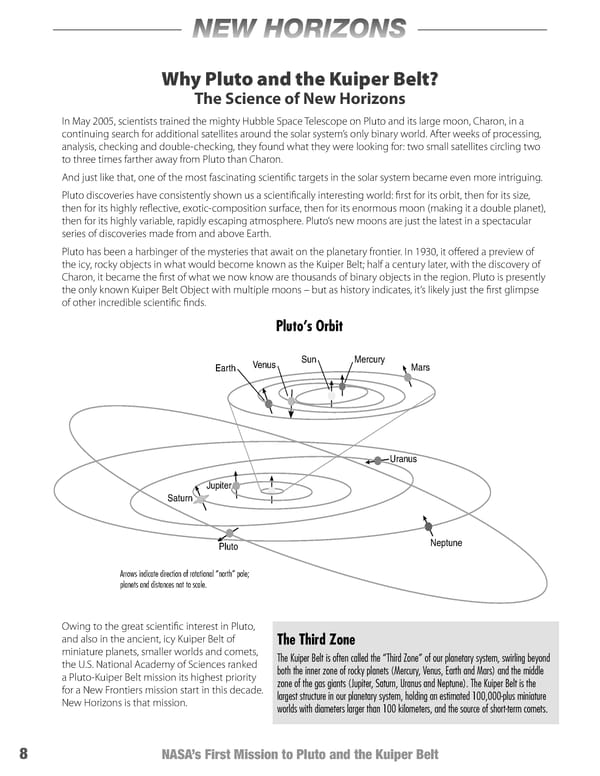NEW HORIZONS Why Pluto and the Kuiper Belt? The Science of New Horizons In May 2005, scientists trained the mighty Hubble Space Telescope on Pluto and its large moon, Charon, in a continuing search for additional satellites around the solar system’s only binary world. After weeks of processing, analysis, checking and double-checking, they found what they were looking for: two small satellites circling two to three times farther away from Pluto than Charon. And just like that, one of the most fascinating scientific targets in the solar system became even more intriguing. Pluto discoveries have consistently shown us a scientifically interesting world: first for its orbit, then for its size, then for its highly reflective, exotic-composition surface, then for its enormous moon (making it a double planet), then for its highly variable, rapidly escaping atmosphere. Pluto’s new moons are just the latest in a spectacular series of discoveries made from and above Earth. Pluto has been a harbinger of the mysteries that await on the planetary frontier. In 1930, it offered a preview of the icy, rocky objects in what would become known as the Kuiper Belt; half a century later, with the discovery of Charon, it became the first of what we now know are thousands of binary objects in the region. Pluto is presently the only known Kuiper Belt Object with multiple moons – but as history indicates, it’s likely just the first glimpse of other incredible scientific finds. Pluto’s Orbit Venus Sun Mercury Mars Earth Uranus Jupiter Saturn Pluto Neptune Arrows indicate direction of rotational “north” pole; planets and distances not to scale. Owing to the great scientific interest in Pluto, and also in the ancient, icy Kuiper Belt of The Third Zone miniature planets, smaller worlds and comets, The Kuiper Belt is often called the “Third Zone” of our planetary system, swirling beyond the U.S. National Academy of Sciences ranked both the inner zone of rocky planets (Mercury, Venus, Earth and Mars) and the middle a Pluto-Kuiper Belt mission its highest priority zone of the gas giants (Jupiter, Saturn, Uranus and Neptune). The Kuiper Belt is the for a New Frontiers mission start in this decade. largest structure in our planetary system, holding an estimated 100,000-plus miniature New Horizons is that mission. worlds with diameters larger than 100 kilometers, and the source of short-term comets. 8 NASA’s First Mission to Pluto and the Kuiper Belt
 New Horizons Page 14 Page 16
New Horizons Page 14 Page 16